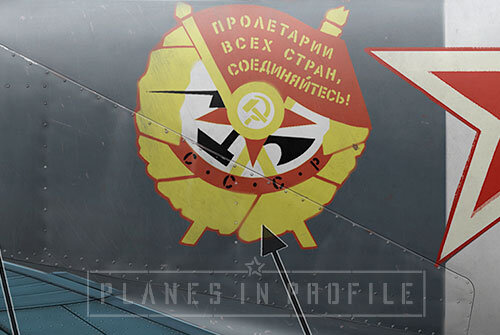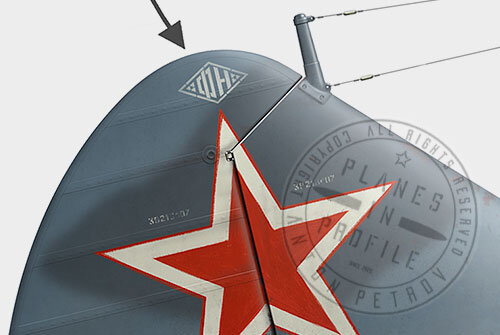Lyubenyuk’s White-07
Lavochkin, La-5FN (Late)
813-th IAP (Osowiecskiy, ‘Order of the Red Banner’ regiment ), 215-th IAD, 8-th IAK, 4-th Air Army, 2-nd Belorussian Front. circa Spring 1945
Thought to have been flown by captain Yuriy Mikhailovich Lyubenyuk.
Apart from the attractive livery of White-07, this plane is of interest because it is thought to have been flown by Yuriy Lyubenyuk in 1945. Lyubenyuk was a fighter pilot who served in the famous 240-th IAP until October 1943 [2]. This was a regiment which produced two of the highest scoring Allied fighter Aces of WW2, Ivan Kozhedub (64 personal victories) and Kirill Evstigneev (52 personal Victories). In fact, during some of Lyubenyuk’s service with this regiment, Kirill Evstigneev was actually his wingman! No doubt that Evstigneev learned a trick or two from junior lieutenant Lyubenyuk. In October 1943 Luybenyuk was transferred to the 813-th IAP where he commanded a squadron and likely flew the La-5FN ‘White-07’ as well as La-7 fighters. He ended the war with 16 victories according to some sources, or 11 personal and 1 shared victory according to Mikhail Bykov’s research.
It is difficult to determine how many victories Lyubenyuk scored in White-07 (if any), but based on the dates in Mikhail Bykov’s book called ‘All of Stalin’s Aces’ Lyubenyuk scored 8 victories during his time in the 813-th IAP during the time when the regiment was most likely already equipped with La-5FN planes. 3 of these victories were scored in 1944 when the regiment took part in Operation ‘Bagration’ - a powerful Soviet offensive which brought about the biggest German defeat in Germany’s military history and led to the liberation of Soviet Belorussia and the destruction of 28 of 34 divisions of Weirmachts Army Group Center [3]. In this operation the regiment performed especially well during the liberation of the town and fortress of Osowiec for which the regiment was given the name ‘Osowieckiy’.
It is likely that the three victories in 1944 might have been scored behind the controls of ‘White-07’ .
24.06.1944 1 FW-189 north-west of Shchedrin (Belarus)
12.08.1944 1 FW-190 Osowiec (Poland)
16.08.1944 1 BF-109 Bronowo (Poland)
5 more victories were scored in 1945. By this time the regiment received some (four to be precise [4]) La-7 airplanes and therefore some of the victories listed below might have been scored by Lyubenyuk while piloting a La-7 instead of the (possibly)‘White-07’ .
18.03.1945 1. FW-190 Кляйн Кольпин (Klein Kolpin?)
18.03.1945 1 FW-190 Прауст (Praust?)
22.03.1945 1 FW-190 аэродромОлива (Oliva airfield?)
23.04.1945 2 FW-190 Костин — Грамбов (Kostin-Grambov?)
[5]
(Please note! in his book M.Bykov writes the names of towns in Russian as I wrote them above. I have translated them letter by letter from Russian into English. These towns might not exist any more or maybe the spelling in russian is different, because I couldn’t find any of these on the map when I Googled them in Russian or letter-by-letter translated into English) The towns listed in the last 5 victories above are probably in north-eastern Germany, or in Poland.
Noteworthy visual characteristics
1) The 'FN' symbol that usually appears on the engine cowling in the area indicated by '1a' was most probably painted over with red.
This symbol was most likely still visible on the tip of the tail, in the area indicated by '1b'.
This symbol represents the FN model of La-5. It's a rhombus with the Cyrillic letters ФН (FN) inside it. These letters have to do with the improved engine which was given a designation M-82FN (or ASh-82FN). The letter ‘F’ is derived from the word ‘Forsirovanniy’ which means forced/boosted and refers to an improved supercharger (Same as in the La-5F ’s engine), and the letter ‘N’ is derived from ‘Neposredstvenniy’ which refers to the direct fuel injection system (as opposed to the one that used a carburetor in the previous models).
This photo shows a very good close-up of what the logo/symbol looks like, even though it’s on a different airplane https://aviaforum.ams3.cdn.digitaloceanspaces.com/data/attachment-files/2020/02/1489950_8f38b1e8d0f9a9034b786c98474180ff.jpg
2) Because no photo reference for the front of the airplane was found, I have tried to base the art on the next best thing - photos of other planes from the regiment. From what I could make out in the bad quality photographs of plane number 70-something (the one behind ‘White-52’), it appears that the cowl bands marked by ‘2a’ might have been painted - they do not reflect the light as one would expect had they been bare metal. The exhaust flap on the other hand does appear to be as reflective as the bare metal exhaust panel, which suggests that the cowl flap (marked by ‘2b’) might have been unpainted bare metal like the panel, or that the paint came off it exposing a lot of bare metal. There is a chance that White-07 might have looked similar, but of course this is just a hypothesis. Either way, this explains my reasoning for choosing to paint these parts of the plane as I did.
3) Note the shape of the heat protection side panel, it is that of the late-type La-5FN.
4) The stencilled artwork represents the Order of the Red Banner. 813-th IAP was awarded this decoration on 19-th Feb 1945 [1] for exemplary execution of combat missions in the battles with the German invaders during the liberation of the southern regions of East Prussia and for the valour and courage shown. The Order of the Red Banner was probably painted on all the planes of the regiment, after the 19-th of Feb.
Because the artwork is stencilled, there is a chance that it might have appeared on both sides of the plane, on the left as well as on the right - but please note, this has not been confirmed and remains a hypothesis! There is also an equal chance that the O.R.B badge didn’t appear on the other side of the plane.
5) The white band around the fuselage is an identification marking of the 813-th fighter regiment.
6) Based on the photo reference, there is a dark spot in the area indicated by the arrow. This might be a defect in the photo, but there is also a chance that this was a repair job of some sort which has been touched up with darker (black?) paint. Or maybe it’s AMT-12 grey that appears darker because it’s a ‘fresher paint job’ .
7) The red spinner and engine cowling was the identification marking of the 8-th IAK. I was unable to find photos of the front of Lyubenyuk's White-07, therefore we don't know with 100% certainty how much of the engine cowling was red exactly. Most profile illustrations portray this airplane with a partially coloured red engine cowling, as per Option '1' below. However, having seen the notes a friend of mine made at the Soviet Military archives, as well as according to THIS PHOTO which shows other planes from the 813-th IAP, I believe that the entire engine cowling of the planes of the 813-th IAP , and therefore of White-07, was most likely painted red, as in option '2' below. Note that this photo was taken before the regiment's planes were painted with the 'Order of the Red Banner' on the fuselage.
Here are a few closeup images to help illustrate the points above. Full set of closeup images is On Patreon
FOOTNOTES
[1] this information is taken from http://ava.org.ru/iap/813.htm
[2] ‘Famous’ because it produced two of the greatest fighter aces of all time - Ivan Kozhedub and Kirill Evstigneev
[3] The info about Operation Bagration is taken from Wikipedia where it was compiled from various sources listed in the footnotes in this link. https://en.wikipedia.org/wiki/Operation_Bagration
[4] According to AVA.org.ru http://ava.org.ru/iap/813.htm 813-th IAP received 4 La-7 airplanes on the 12-th December 1944.
[5] The list of victories above is taken from Mikhail Bykov’s book called ‘Все Асы Сталина’ (All of Stalin’s Aces), page 239. Youza-press, 2014.
LINKS TO THE REFERENCE IMAGES AND/OR VIDEOS
All the work presented on this is page is subject to updates and revisions in the light of new information which might present itself. If you have any new information relevant to this page or disagree with anything that's presented here, then please feel free to contact me through the Planes in Profile Facebook page. Thanks:)
Special thanks to Alex Valyaev for his help in making this airplane look more historically accurate.






